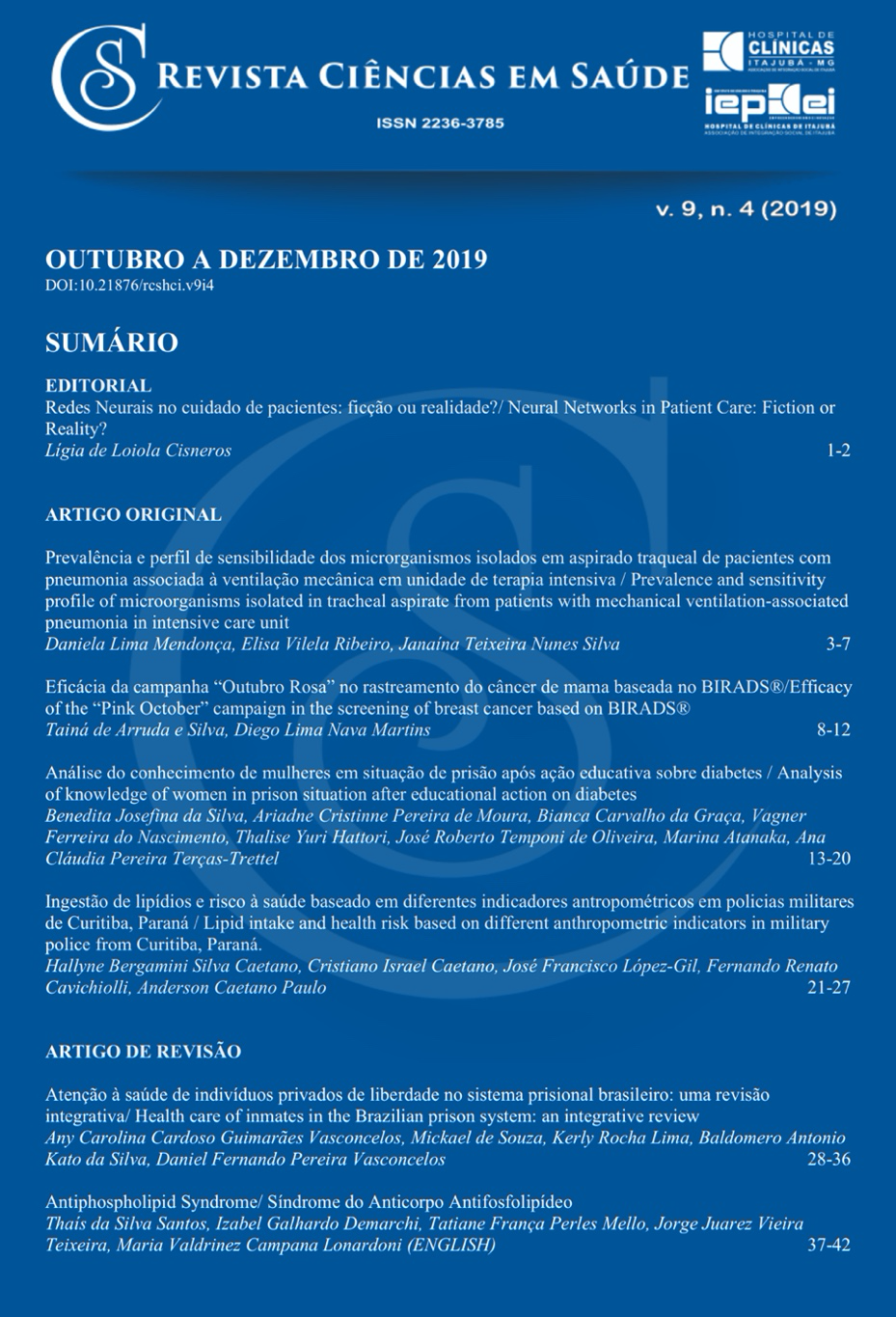Efficacy of the “Pink October” campaign in the screening of breast cancer based on BIRADS®
Main Article Content
Abstract
Introduction: Breast cancer is the second most common neoplasm among women in the world and the most frequent cause of death. Mammography is the main imaging tool for screening and early diagnosis. Objective: To analyze the impact of the health policy campaign "Pink October" on the early diagnosis of breast cancer and the result of its social marketing strategies. Methods: An observational, descriptive, cross-sectional and retrospective study was performed, based on the collection and analysis of mammography records of SISMAMA, standardized in the Breast Imaging Reporting and Data System (BIRADS®) performed at a quaternary Hospital in 2016. Results: A total of 1.844 exams were performed in the diagnostic imaging department. The analysis of the exams done before (January to September) and after (October to December) the showed a statistically significant increase in the average number of exams after "Pink October" (125,8 exams/month vs 237,3 exams/month; p = 0,003). It was observed that the BIRADS® 2 category (benign mammographic findings) represented the majority of the results (40.9%). There was no statistically significant difference between BIRADS® categorization in October compared to the other months of the year. Conclusion: It was possible to demonstrate that the "Pink October" campaign achieved its goal, as a public health policy, to stimulate screening of breast cancer in Brazilian women.
Article Details
Authors maintain copyright and grant the HSJ the right to first publication. From 2024, the publications wiil be licensed under Attribution 4.0 International 
 , allowing their sharing, recognizing the authorship and initial publication in this journal.
, allowing their sharing, recognizing the authorship and initial publication in this journal.
Authors are authorized to assume additional contracts separately for the non-exclusive distribution of the version of the work published in this journal (e.g., publishing in an institutional repository or as a book chapter), with acknowledgment of authorship and initial publication in this journal.
Authors are encouraged to publish and distribute their work online (e.g., in institutional repositories or on their personal page) at any point after the editorial process.
Also, the AUTHOR is informed and consents that the HSJ can incorporate his article into existing or future scientific databases and indexers, under the conditions defined by the latter at all times, which will involve, at least, the possibility that the holders of these databases can perform the following actions on the article.
References
Câncer de Mama [Intenet site] Instituto Nacional do Câncer. [Access 29 Sept 2019]. Disponível em: https://www.inca.gov.br/tipos-de-cancer/cancer-de-mama.
Azevedo DB, Moreira JC, Gouveia PA, Tobias GC, Morais Neto OL. Perfil de mulheres com câncer de mama. Rev Enferm UFPE. 2017;11(6):2264-72.
Azevedo e Silva G, Souza-Júnior PRB, Damacena GN, Szwarcwald CL. Detecção precoce do câncer de mama no Brasil: dados da Pesquisa Nacional de Saúde, 2013. Rev Saúde Pública. 2017;51(Supl 1):14s. DOI: 10.1590/s1518-8787.2017051000191
Haddad C F. Análise dos resultados de mamografias de rastreamento realizadas em um serviço público do interior de Minas Gerais. Rev Bras Mastologia. 2016;26(4):175-80. DOI: 10.5327/Z201600040007RBM
Shapiro S, Venet W, Strax P, Venet L, Roeser R. Ten- to fourteen-year effect of screening on breast cancer mortality. J Natl Cancer Inst. 1982;69(2):349-55.
BRASIL. Instituto Nacional de Câncer. Ministério da Saúde. Mamografia: da prática ao controle. Recomendação para profissionais de saúde. Rio de Janeiro: INCA,2007.
Freitas AG, Kemp C, Louveira MH, Fujiwara SM, Campos LF. Mamografia digital: perspectiva atual e aplicações futuras. Radiologia Bras. 2006;39(4):287-96.DOI: 10.1590/S0100-39842006000400012
CBR, Boletim CBR. Outubro Rosa. Informativo. 2013;n305:16-9. Disponível em: https://cbr.org.br/wp-content/uploads/2017/08/pdf/Boletim-CBR-Outubro-2013.pdf
Instituto Nacional de Câncer José Alencar Gomes da Silva. Diretrizes para a detecção precoce do câncer de mama no Brasil/ Instituto Nacional de Câncer José Alencar Gomes da Silva – Rio de Janeiro: INCA, 2015. 168
Brasil. Ministério da Saúde. Secretaria de Vigilância em Saúde. Departamento de Análise de Situação de Saúde. Plano de ações estratégicas para o enfrentamento das doenças crônicas não transmissíveis (DCNT) no Brasil 2011-2022 / Ministério da Saúde. Secretaria de Vigilância em Saúde. Departamento de Análise de Situação de Saúde. Brasília: Ministério da Saúde, 2011;160.
Instituto Nacional de Câncer (Brasil). Coordenação Geral de Ações Estratégicas. Divisão de Apoio à Rede de Atenção Oncológica. Sistema de informação do controle do câncer de mama (SISMAMA) e do câncer do colo do útero (SISCOLO): manual gerencial / Instituto Nacional de Câncer. Coordenação Geral de Ações Estratégicas. Divisão de Apoio à Rede de Atenção Oncológica. Rio de Janeiro: INCA, 2011
Instituto Nacional de Câncer José Alencar Gomes da Silva. Sistema de informação do câncer: manual preliminar para apoio à implantação /Instituto Nacional de Câncer José Alencar Gomes da Silva. Rio de Janeiro: INCA, 2013;143.
Vieira AV, Toigo FT. Classificação BI-RADS™: Categorização de 4.968 mamografias. Radiologia Bras. 2002; 35 (4): 205-8.
American College of Radiology. Breast Imaging Reporting and data system (BI-RADS®). ACR BI-RADS Atlas 5 th Edition 2013.
Martins CA, Guimarães RM, Silva RLPD, Ferreira APS, Gomes FL, Sampaio JRC et al. Evolução da Mortalidade por Câncer de Mama em Mulheres Jovens: Desafios para uma Política de Atenção Oncológica. Rev Bras Cancerol.2013;59(3):341-9.
Martins AFH, Barbosa TRC, Cezar LC. Análise da Campanha Outubro Rosa de prevenção do câncer de mama em Viçosa, MG. Revista de Ciências Humanas. 204;14(2): 539-56.
Vazzoller PR, Fernandes YCF, Gotardo BA, Ruhnke J, Gomes DS. Impact of the Pink October in the mammographic screen-ing adherence in a reference center in oncology. Mastology, 2017;27(3):194-8. DOI: 10.5327/Z2594539420170000212
